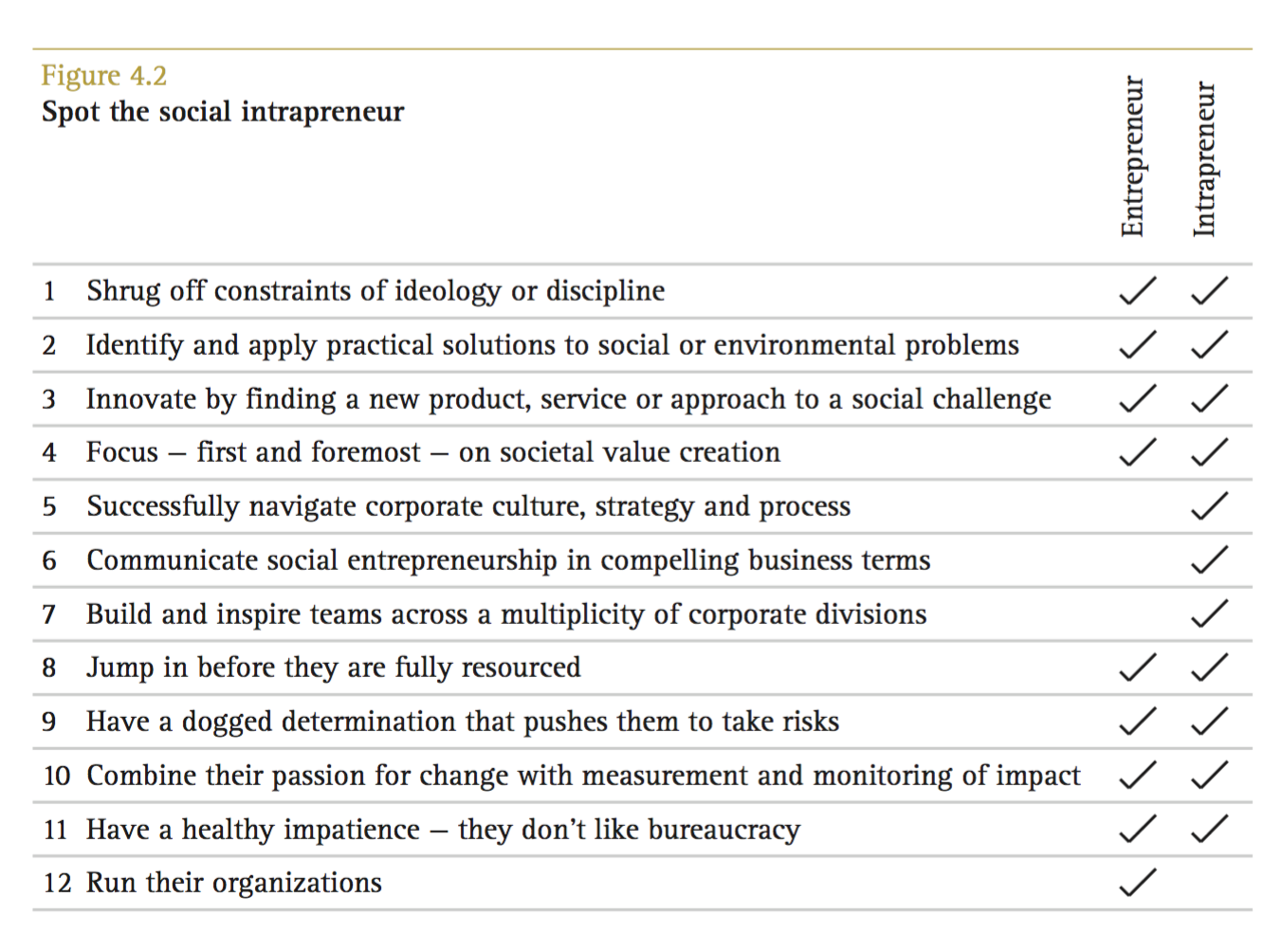M-PESA might be one of the most successful social innovations of the last decade. The phone-based money transfer service allows users to store and exchange monetary value over text message. Launched in 2007, it now connects more than 30 million users in 10 countries to the modern global economy, even without local banking infrastructure or smart phones. A 2016 study found that the service has helped lift many Kenyans out of extreme poverty. But M-PESA wasn’t created by a well-meaning nonprofit or a disruptive, purpose-driven startup: it was born from inside Vodafone, one of the world’s largest telecom companies, shepherded by a small team of social intrapreneurs who saw an opportunity to create major societal change from within a big corporation.
While nonprofits, social enterprise startups, and mission-driven conscious companies might seem like the most obvious employment targets for purpose-oriented job seekers, there’s another important and viable path to impact to consider: intrapreneurship.
What is Social Intrapreneurship?
“Intrapreneurs are a species of changemaker who look, sound, and act like social entrepreneurs, but from the inside of a large business,” explains Maggie De Pree, co-founder of the League of Intrapreneurs, a global membership organization that connects and supports corporate changemakers. “I see them as almost activists within an organization.”
Intrapreneurs operate from any and all departments and levels of an organization. They may develop a new product, service, or business model — like M-PESA. They may work to change corporate policies, either for employees or with regard to how the company engages with external stakeholders, including suppliers, customers, their community, and the environment. The value they create can be monetary, from new revenue or cost savings, or relate to brand reputation, company culture, community engagement, etc. “For me it’s less about what they’re working on and more about how they’re doing it and what they’re driving towards,” says De Pree. “The north star for our intrapreneurs is systems change. Intrapreneurs don’t work for their organization, they work from it. The company is the platform from which they can drive change.”

The difference between intrapreneurs and entrepreneurs. Source: “The Social Intrapreneur: A Field Guide for Corporate Changemakers” (SustainAbility, 2008)
Why Intrapreneurship Can Be a Good Option
“As an intrapreneur, you have a lot of benefits that you don’t have as an entrepreneur,” explains Hans Balmaekers, director at Innov8rs, which convenes conferences for intrapreneurs around the world. “Big companies have a lot of resources: distribution channels, existing products, a client base — pros that any entrepreneur dreams of having. You can launch a big product with a big team for millions of people. Inside a large company, there are so many opportunities, so many people wanting to engage with you on those opportunities, and so many things to build upon. For me it’s the obvious choice.”
Beyond the potential to scale your impact, other advantages of intrapreneurship include the potential to create societal change while staying in your current job, lower financial risk, and the collaboration and leadership skills intrapreneurship can help you develop.
The Challenges of Intrapreneurship
Intrapreneurs face challenges that entrepreneurs or nonprofit employees don’t, however. The biggest one is overcoming the inertia of a large organization. “By nature, most humans resist change,” Balmaekers says, “and most big organizations are well-oiled machines that have been optimized to serve the goal of creating profit.” In general, it’s easiest to sell a company on a money-making idea or cost-saving, and the environment needs to be a least somewhat open to innovation — intrapreneurship isn’t a cure for a truly toxic culture. It also takes a lot of patience to earn trust, and it can be lonely to be a voice for change — so building community with other changemakers outside the company can be key.
Meanwhile, because they work within an existing system, intrapreneurs sometimes need to break rules or ask for forgiveness, not for permission. “It’s for sure that some people won’t like what you’re doing,” Balmaekers adds. “Your career is probably more at risk.” That’s why, in addition to the abilities successful intrapreneurs share with entrepreneurs, such as sensing opportunities and aligning them with business strategy, intrapreneurs must also cultivate a keen political sensitivity and understand how to navigate the complex system of a corporation.
Yet the challenges can offers advantage, too, says De Pree: “Intrapreneurs are modeling twenty-first century leadership. It’s more feminine, more collaborative, and super low-ego. It’s more about doing and prototyping than just strategizing.”
And Balmaekers is clear about the payoff. “Most, maybe all intrapreneurs I know, couldn’t just sit there and ‘behave,’” he says. “They have a personal belief that things should be better and can be different, and then they accept the challenges.”
Learn More
Over the next six months, in partnership with Marylhurst University, we’ll be releasing a series of articles all about intrapreneurship, featuring success stories, advice from the trenches, key challenges, best practices, and more. Stay tuned to our Social Intrapreneurship channel for the latest articles, and email us at info@consciouscomag.com if you have an intrapreneurship question or success story to share.





